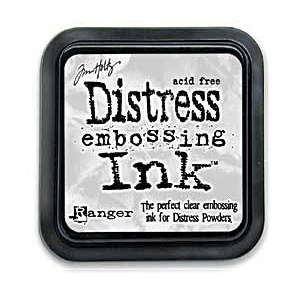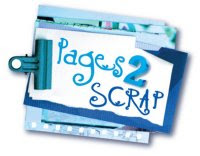One of the questions I get asked most often is about the different types of ink pads and what they are used for. There are quite a few different brands and types of inks out there and it can get very confusing. So I thought I'd pop in today to try and demystify some of them for you!
It is important to note that whilst a certain ink pad may fall under a certain category, the way it behaves and it's uses can be very different to others in the same category from other brands. It is always best to read the information on the back of your ink pads, or refer to the manufacturer's websites if you are unsure of what you can use them for.
Tim Holtz Distress Inks are a collection of 36 acid-free, non-toxic, fade resistant, water-based dye inks. This means that you can create lots of different techniques using water with your Distress Ink, such as Tim's Wrinkle Free Distress technique. Tim selected the colors and helped develop these inks to produce a realistic, weathered look on paper, photos and decorative fibers. The 2" x 2" pads are made with a higher raised felt for easier use with direct to paper techniques. It is possible to heat emboss with distress inks as well, because they stay wet longer than normal dye inks.
StazOn:
Pigment Inks:
Choose a pigment ink if you're planning on doing any heat embossing with embossing powders. Pigment inks are thick and take longer to dry which is why they are perfect for embossing with. Pigment inks usually won't dry on metal or acetate - you're best off reading the back of your inkpad to clarify, or just sticking to paper or cardstock. Pigment inks are usually opaque and the ink pad itself is usually soft and spongy. Popular pigment ink brands include Versacolor, VersaMagic, Brilliance, and the Adirondack Pigment inks.
The Adirondack pigment inks are formulated slightly differently to normal pigment inks in that they can be heat set on gloss paper, vellum, shrink plastic, metal and glass.
Opalite inks are also Pigment inks, however they are a reflective interference ink which are best used on dark or black card to show off their pearlescent sheen.
Clear Embossing Inks:
The most popular clear embossing ink is VersaMark.
Versamark is most commonly used for stamping images before heat embossing with embossing powders. However, you can also use it to create watermark images on coloured papers and cardstock. Because the formulation is so sticky, it can also act as a glue for use with chalks and pigment powders such as Perfect Pearls.
There is also a clear embossing ink in the Distress range of Inks from Ranger:
This ink pad can be used in the same was as Versamark, and is formulated to give you the optimum performance when embossing with Distress Embossing Powders.
Distress Inks:
Tim Holtz Distress Inks are a collection of 36 acid-free, non-toxic, fade resistant, water-based dye inks. This means that you can create lots of different techniques using water with your Distress Ink, such as Tim's Wrinkle Free Distress technique. Tim selected the colors and helped develop these inks to produce a realistic, weathered look on paper, photos and decorative fibers. The 2" x 2" pads are made with a higher raised felt for easier use with direct to paper techniques. It is possible to heat emboss with distress inks as well, because they stay wet longer than normal dye inks.
Dye Inks:
Dye inks are quick drying inks that are usually characterised by a raised felt ink pad. They are usually either water based or oil based, and can be made permanent by heat setting with a heat gun. Permanent non-smear inks such as the Archival Ink brand are best to use with Distress inks and any watercolour techniques. Popular brands of dye inks are the Adirondak Dye inks, Kaleidacolor, and the Distress Inks as mentioned above.
Another popular Dye ink is the Memento range of inks. Fast drying and fade resistant, they are the most popular pad used to stamp images to colour with Copic Markers - as they are water based, water resistant, and do not migrate.
Stazon is a quick drying solvent based ink, specifically designed for use on non-porous and semi-porous surfaces like metal, acetate, plastic, acrylic, leather, and glass. Of course, it is also great on normal paper and cardstock. You will find that StazOn inks will stain your rubber and acrylic stamps - and you will only be able to clean it off with a solvent cleaner like the Stazon Remover.
Speacialty Ink Pads:
There are a number of other ink pads that have been created for special purposes, such as glue pads for use with glitter, pearl powders etc, or Castaway ink which once heated gives a bleach effect similar to Batik.
So there you have it! Now if hubby asks you why you have 5 different black ink pads, you can explain to him why! LOL!
If you have any questions, or would like any further info on a particular type of ink pad, please let me know in the comments section! :)
~Sarah~





















No comments:
Post a Comment